Transcriptome profile of rat genes in injured spinal cord at different stages by RNA-sequencing
- PMID: 28201982
- PMCID: PMC5312572
- DOI: 10.1186/s12864-017-3532-x
Transcriptome profile of rat genes in injured spinal cord at different stages by RNA-sequencing
Abstract
Background: Spinal cord injury (SCI) results in fatal damage and currently has no effective treatment. The pathological mechanisms of SCI remain unclear. In this study, genome-wide transcriptional profiling of spinal cord samples from injured rats at different time points after SCI was performed by RNA-Sequencing (RNA-Seq). The transcriptomes were systematically characterized to identify the critical genes and pathways that are involved in SCI pathology.
Results: RNA-Seq results were obtained from total RNA harvested from the spinal cords of sham control rats and rats in the acute, subacute, and chronic phases of SCI (1 day, 6 days and 28 days after injury, respectively; n = 3 in every group). Compared with the sham-control group, the number of differentially expressed genes was 1797 in the acute phase (1223 upregulated and 574 downregulated), 6590 in the subacute phase (3460 upregulated and 3130 downregulated), and 3499 in the chronic phase (1866 upregulated and 1633 downregulated), with an adjusted P-value <0.05 by DESeq. Gene ontology (GO) enrichment analysis showed that differentially expressed genes were most enriched in immune response, MHC protein complex, antigen processing and presentation, translation-related genes, structural constituent of ribosome, ion gated channel activity, small GTPase mediated signal transduction and cytokine and/or chemokine activity. Kyoto Encyclopedia of Genes and Genomes (KEGG) pathway analysis showed that the most enriched pathways included ribosome, antigen processing and presentation, retrograde endocannabinoid signaling, axon guidance, dopaminergic synapses, glutamatergic synapses, GABAergic synapses, TNF, HIF-1, Toll-like receptor, NF-kappa B, NOD-like receptor, cAMP, calcium, oxytocin, Rap1, B cell receptor and chemokine signaling pathway.
Conclusions: This study has not only characterized changes in global gene expression through various stages of SCI progression in rats, but has also systematically identified the critical genes and signaling pathways in SCI pathology. These results will expand our understanding of the complex molecular mechanisms involved in SCI and provide a foundation for future studies of spinal cord tissue damage and repair. The sequence data from this study have been deposited into Sequence Read Archive ( http://www.ncbi.nlm.nih.gov/sra ; accession number PRJNA318311).
Keywords: GO enrichment; Pathway analysis; RNA-Seq; Spinal cord injury; Sprague-Dawley rats (RRID:RGD_70508).
Figures
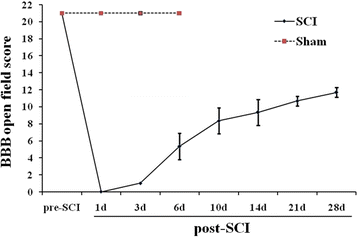
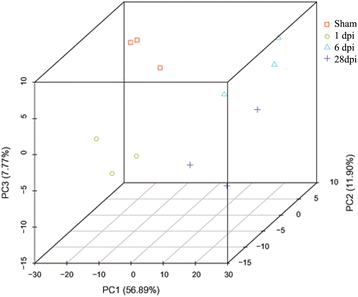
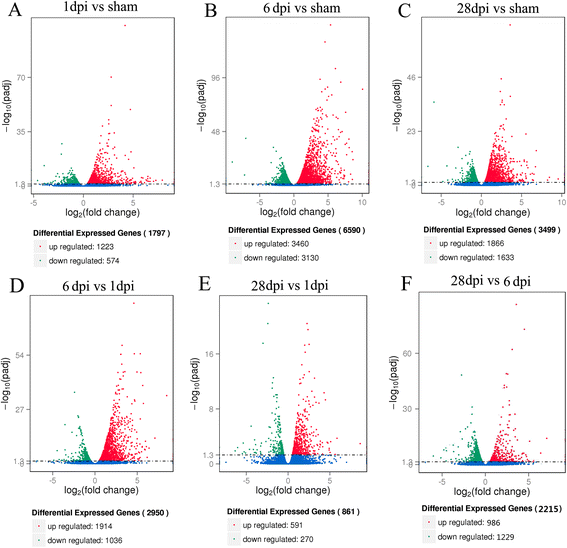
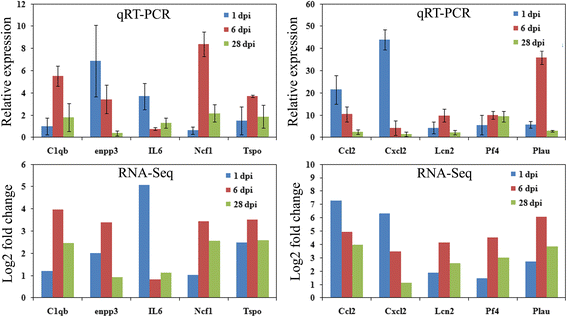
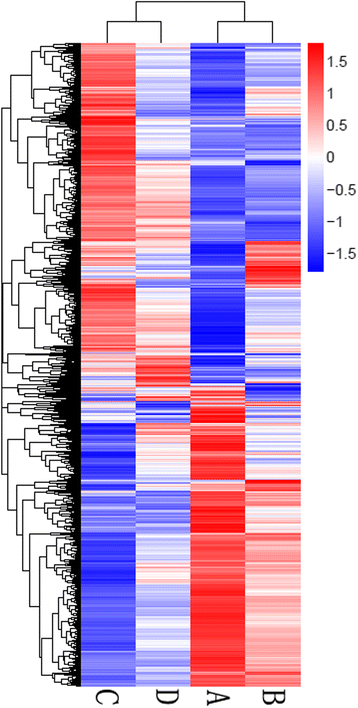

Similar articles
-
Investigation of candidate long noncoding RNAs and messenger RNAs in the immediate phase of spinal cord injury based on gene expression profiles.Gene. 2018 Jun 30;661:119-125. doi: 10.1016/j.gene.2018.03.074. Epub 2018 Mar 23. Gene. 2018. PMID: 29580899
-
A transcriptomic study of probenecid on injured spinal cords in mice.PeerJ. 2020 Jan 3;8:e8367. doi: 10.7717/peerj.8367. eCollection 2020. PeerJ. 2020. PMID: 31921518 Free PMC article.
-
Elucidation of Gene Expression Patterns in the Brain after Spinal Cord Injury.Cell Transplant. 2017 Jul;26(7):1286-1300. doi: 10.1177/0963689717715822. Cell Transplant. 2017. PMID: 28933220 Free PMC article.
-
Microarray and Bioinformatics Analysis of Differential Gene and lncRNA Expression during Erythropoietin Treatment of Acute Spinal Cord Injury in Rats.Comput Math Methods Med. 2022 Sep 2;2022:4121910. doi: 10.1155/2022/4121910. eCollection 2022. Comput Math Methods Med. 2022. Retraction in: Comput Math Methods Med. 2023 Dec 6;2023:9843413. doi: 10.1155/2023/9843413. PMID: 36092786 Free PMC article. Retracted. Review.
-
Bioinformatics Genes and Pathway Analysis for Chronic Neuropathic Pain after Spinal Cord Injury.Biomed Res Int. 2017;2017:6423021. doi: 10.1155/2017/6423021. Epub 2017 Oct 15. Biomed Res Int. 2017. PMID: 29164149 Free PMC article. Review.
Cited by
-
RNA sequencing screening of differentially expressed genes after spinal cord injury.Neural Regen Res. 2019 Sep;14(9):1583-1593. doi: 10.4103/1673-5374.255994. Neural Regen Res. 2019. PMID: 31089057 Free PMC article.
-
Gut microbiota and transcriptome dynamics in every-other-day fasting are associated with neuroprotection in rats with spinal cord injury.Front Microbiol. 2023 Jul 28;14:1206909. doi: 10.3389/fmicb.2023.1206909. eCollection 2023. Front Microbiol. 2023. PMID: 37577426 Free PMC article.
-
Characterization of the Expressions and m6A Methylation Modification Patterns of mRNAs and lncRNAs in a Spinal Cord Injury Rat Model.Mol Neurobiol. 2025 Jan;62(1):806-818. doi: 10.1007/s12035-024-04297-z. Epub 2024 Jun 22. Mol Neurobiol. 2025. PMID: 38907070 Free PMC article.
-
Molecular insights into the mechanisms of a leaf color mutant in Anoectochilus roxburghii by gene mapping and transcriptome profiling based on PacBio Sequel II.Sci Rep. 2023 Dec 20;13(1):22751. doi: 10.1038/s41598-023-50352-5. Sci Rep. 2023. PMID: 38123722 Free PMC article.
-
Transcriptome Profiling after Early Spinal Cord Injury in the Axolotl and Its Comparison with Rodent Animal Models through RNA-Seq Data Analysis.Genes (Basel). 2023 Dec 8;14(12):2189. doi: 10.3390/genes14122189. Genes (Basel). 2023. PMID: 38137011 Free PMC article.
References
Publication types
MeSH terms
LinkOut - more resources
Full Text Sources
Other Literature Sources
Medical
Research Materials

